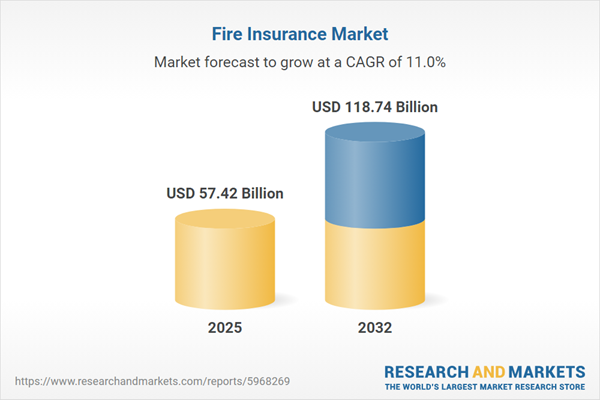Speak directly to the analyst to clarify any post sales queries you may have.
The fire insurance market is undergoing rapid transformation, driven by shifting risk environments, evolving compliance requirements, and accelerated adoption of digital solutions. Senior executives are tasked with reinforcing resilience among their organizations by implementing advanced protection strategies tailored to a complex and changing landscape. This overview presents essential insights, actionable guidance, and strategic considerations relevant for business leaders managing risk and continuity in the modern era.
Fire Insurance Market Snapshot
The global fire insurance market is demonstrating steady growth, progressing from USD 51.69 billion in 2024 to USD 57.42 billion in 2025, and achieving a projected compound annual growth rate (CAGR) of 10.95% through 2032. This upward trend is propelled by the integration of automation and artificial intelligence in underwriting and claims management, resulting in more adaptive responses to compliance protocols and diverse client demands. Insurers are advancing digital solutions for enhanced risk assessment and streamlined workflows, allowing for better identification of both traditional and emerging threats. Heightened digital transformation is setting new benchmarks for decision-makers, especially as enterprises address greater regulatory scrutiny and the impacts of severe weather events.
Scope & Segmentation: Global Fire Insurance Market
- Distribution Channels: Agents, brokers, bancassurance, direct sales, mobile platforms, and insurer portals each offer flexible solutions, enabling clients to select between personalized advisory services and self-directed purchasing models tailored to their operational requirements.
- Product Types: Commercial, industrial, and residential fire insurance products comprehensively cover property and liability, supporting rigorous risk management and accommodating a breadth of peril types, including both environmental and natural risks.
- End Users: Corporations, public sector entities, and individuals all depend on fire insurance solutions to safeguard critical assets, meet stringent compliance demands, and support continuity initiatives. Digitalization across the value chain is enhancing policy administration and claims efficiency for all stakeholders.
- Policy Types: Both new fire insurance policies and renewals are designed for operational flexibility, including efficient onboarding, easy updates, and seamless modifications. This adaptability helps both large-scale enterprises and smaller organizations more precisely address their changing risk environment.
- Regions: Market characteristics differ across the Americas, Europe, Middle East & Africa, and Asia-Pacific. While the US and China champion digital innovation, insurers everywhere are customizing offerings to reflect localized risks and regulatory structures, fostering a diverse and resilient sector.
- Leading Companies: Key providers such as People’s Insurance Company (Group) of China Limited, Allianz SE, AXA SA, Ping An Insurance (Group) Company of China, Assicurazioni Generali S.p.A., Zurich Insurance Group AG, Chubb Limited, Tokio Marine & Nichido Fire Insurance Co., American International Group, and Liberty Mutual Insurance Company are investing in digital infrastructure, expanding their global reach, and developing varied portfolios to align with evolving client needs.
Fire Insurance Market: Key Takeaways for Senior Leaders
- Advanced analytics are driving faster hazard detection and streamlining claims resolution, enabling more proactive service with technologies such as real-time satellite data and risk mapping.
- Dynamic risk modeling enables organizations to manage complex exposures more effectively, improving preparedness for both climate-driven and urban risk scenarios.
- Shifting regulatory contexts are prompting industry stakeholders to reassess capital strategies and explore innovative risk transfer mechanisms like catastrophe bonds and parametric policies.
- Corporate buyers emphasize process transparency and operational efficiency, leveraging digital advisory platforms, robust documentation, and real-time monitoring to optimize policy management.
- Solution design adapts to regional priorities: the Americas see a rise in bundled and parameterized products; EMEA markets focus on compliance-driven offerings; rapid digital scaling characterizes the Asia-Pacific region.
- Collaboration between insurers and technology specialists is accelerating compliant product launches and sharpening response to ongoing regulatory and operational changes.
Tariff Impact: Managing Cost Pressures
Recent tariff changes in the United States—affecting reinsurance costs and equipment sourcing—are influencing how businesses structure their risk retention and insurance programs. Organizations are responding by blending traditional policies with parameter-based protection to better manage premiums and coverage limits. Enhanced supply chain oversight and stronger stakeholder coordination are supporting continued operational stability and improved policy performance.
Methodology & Data Sources
This report synthesizes findings from executive interviews, in-depth regulatory document analysis, and academic research. Validation is supported by stochastic modeling and geospatial analytics, providing board-level decision-makers with robust, evidence-based insights.
Why This Report Matters
- Benchmark the maturity of your organization’s digital transformation and identify best practices in underwriting and risk governance as implemented by global insurers.
- Access strategic recommendations for modernizing underwriting and claims management while navigating rapidly changing technology and compliance landscapes.
- Develop informed investment approaches by understanding the main growth drivers shaping fire insurance markets across all major regions.
Conclusion
Aligning advanced technology with agile planning gives organizations an edge in resilience, regulatory compliance, and risk management. By prioritizing innovation and strategic partnerships, senior leaders can secure strong positioning in an evolving fire insurance marketplace.
Additional Product Information:
- Purchase of this report includes 1 year online access with quarterly updates.
- This report can be updated on request. Please contact our Customer Experience team using the Ask a Question widget on our website.
Table of Contents
3. Executive Summary
4. Market Overview
7. Cumulative Impact of Artificial Intelligence 2025
Companies Mentioned
The companies profiled in this Fire Insurance market report include:- People's Insurance Company (Group) of China Limited
- Allianz SE
- AXA SA
- Ping An Insurance (Group) Company of China, Ltd.
- Assicurazioni Generali S.p.A.
- Zurich Insurance Group AG
- Chubb Limited
- The Tokio Marine & Nichido Fire Insurance Co., Ltd.
- American International Group, Inc.
- Liberty Mutual Insurance Company
Table Information
| Report Attribute | Details |
|---|---|
| No. of Pages | 184 |
| Published | October 2025 |
| Forecast Period | 2025 - 2032 |
| Estimated Market Value ( USD | $ 57.42 Billion |
| Forecasted Market Value ( USD | $ 118.74 Billion |
| Compound Annual Growth Rate | 10.9% |
| Regions Covered | Global |
| No. of Companies Mentioned | 11 |









